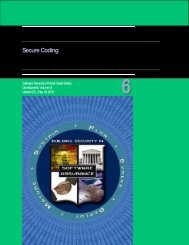Architecture and Design Considerations - Build Security In - US-CERT
Architecture and Design Considerations - Build Security In - US-CERT
Architecture and Design Considerations - Build Security In - US-CERT
Create successful ePaper yourself
Turn your PDF publications into a flip-book with our unique Google optimized e-Paper software.
Architectural-level Patterns<br />
Architectural-level patterns focus on the high-level allocation of responsibilities between different components of the system <strong>and</strong><br />
define the interaction between those high-level components <strong>and</strong> include:<br />
Distrustful Decomposition – The intent of the Distrustful Decomposition secure design pattern is to move separate functions<br />
into mutually untrusting programs, thereby reducing the attack surface of the individual programs that make up the system’s<br />
functionality <strong>and</strong> the data exposed to an attacker if one of the mutually untrusting programs is compromised. This pattern applies<br />
to systems where files or user-supplied data must be h<strong>and</strong>led in a number of different ways by programs running with varying<br />
privileges <strong>and</strong> responsibilities.<br />
Privilege Separation (PrivSep) – The intent of the PrivSep pattern is to reduce the amount of code that runs with special<br />
privileges; without affecting or limiting the functionality of the program. The PrivSep pattern is a more specific instance of the<br />
Distrustful Decomposition pattern. <strong>In</strong> general, the PrivSep pattern is applicable if the system performs a set of functions that:<br />
» Do not require elevated privileges;<br />
» Have relatively large attack surfaces;<br />
» Have significant communication with untrusted sources;<br />
<strong>and</strong><br />
» Make use of complex, potentially error-prone algorithms.<br />
Defer to Restricted Application or Area – The intent of this pattern<br />
is to clearly separate “functionality that requires elevated privileges”<br />
from “functionality that does not require elevated privileges.” The<br />
“defer to restricted application or area” pattern is applicable to<br />
systems:<br />
» That run by users who do not have elevated privileges;<br />
» Where some (possibly all) of the functionality of the system<br />
requires elevated privileges; or<br />
» Where the system must verify that the current user is<br />
authorized to execute any functionality that requires<br />
elevated privileges.<br />
One way this can be done is by taking advantage of existing user<br />
verification functionality available at the kernel level. However this<br />
Figure 4: General Structure of Defer to Kernel<br />
Pattern (source: Secure <strong>Design</strong> Patterns)<br />
may not always be the best course of action, especially in the case of web applications in which untrusted data could come over<br />
the <strong>In</strong>ternet <strong>and</strong> should not be sent to the kernel level. An alternative to this is to use a central application or database that has<br />
restricted access <strong>and</strong> can perform the same user verification actions as the kernel. Figure 4 depicts the general structure of the<br />
“defer to restricted application or area” pattern, using the kernel as its reference.<br />
The three architectural-level patterns described in this section provide techniques to prevent improper authorization <strong>and</strong> promote<br />
privilege control. The Common Weakness Enumeration (CWE) [see http://cwe.mitre.org] defines a unified, measurable set of<br />
software weaknesses such as improper authorization <strong>and</strong> execution with unnecessary privileges. Common techniques for<br />
privilege control <strong>and</strong> proper authorizations provided by CWE are:<br />
» Divide applications into anonymous, normal, privileged, <strong>and</strong> administrative areas (CWE-285).<br />
» Reduce the attack surface by mapping roles with data <strong>and</strong> functionality <strong>and</strong> use role-based access control (RBAC) to<br />
enforce the roles at the appropriate boundaries (CWE-285).<br />
» Use authorization frameworks such as the JAAS Authorization Framework <strong>and</strong> the OWASP ESAPI Access Control<br />
feature (CWE-285).<br />
» For web applications, make sure that the access control mechanism is enforced correctly, at the server-side, on every<br />
page. Users should not be able to access any unauthorized functionality or information by simply requesting direct<br />
<strong>Architecture</strong> <strong>and</strong> <strong>Design</strong> <strong>Considerations</strong> for Secure Software 14
















